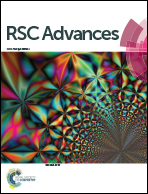Photo-polymerisable electrospun fibres of N-methacrylate glycol chitosan for biomedical applications†
Abstract
The availability of nanofibrous substrates with engineered properties, such as controlled porosity, mechanical conformability, biodegradation profile and drug release, is of strategic importance in the biomedical sector. Here, we demonstrate that N-methacrylate glycol chitosan, a photo-polymerisable, biocompatible and water-soluble derivative of chitosan, can be easily processed to create non-woven mats of nanofibres with controlled physicochemical characteristics. The produced fibrous mats are characterised by thermal stability, Young's modulus of 140 MPa and ultimate strength of 4 MPa. The degree of cross-linking of the realised fibres regulates their durability and degradation profile under conditions of high humidity, but also allows controlling the delivery over time of active agents encapsulated inside the fibres. We demonstrate that the N-methacrylate glycol chitosan nanofibres are able to release an antimicrobial drug within 24 hours. Moreover, cells proliferation of 85% indicates that non-cytotoxic substances were released from the electrospun mats.


 Please wait while we load your content...
Please wait while we load your content...